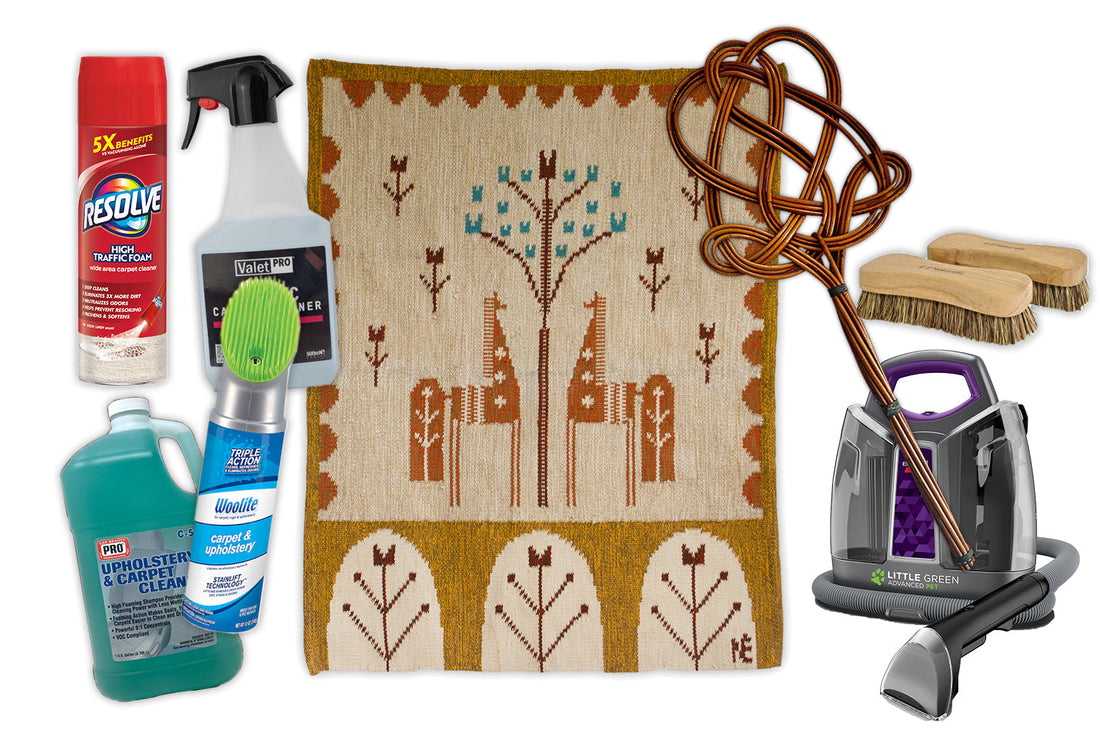
How to clean a handwoven wool tapestry?
How to Care for Vintage Wool Tapestries: Expert Tips for Mid-Century Modern Collectors
Wool - and other natural animal fibers - is one of the most beautiful, resilient materials used in textile design. In its raw form, wool protects animals in all weather conditions - sun, rain, mud, snow - without losing integrity. Imagine a sheep grazing in the elements: its fleece holds up remarkably well. 🐑✨
But once that wool is removed, processed, dyed, and woven into a handmade wool tapestry or vintage wall hanging, it becomes far more delicate - and requires special care.
If you’re a collector of mid-century modern textiles or vintage home decor, this guide will show you how to care for your wool tapestries to keep them vibrant and lasting for decades to come.

Always Start with the Care Label - If There Is One
When it comes to cleaning a handwoven wool rug or wool wall tapestry, always follow the care instructions or laundry label if it’s available. Unfortunately, many vintage textiles - especially one-of-a-kind or artisan-made pieces - don’t include care tags, so it’s crucial to know the dos and don’ts.

"Handwoven rug"
Material: 86% wool, 14% cotton
CARE INSTRUCTIONS
Cleaning: With Domál or Extra carpet cleaner [popular detergents in 1970s Hungary], according to the instructions on the cleaner
Drying: laid, away from heat sources and radiators, at room temperature
Ironing: if necessary, with a warm iron, through a wet cloth, lightly pressed
Lessons from a Collector: The Beauty and Fragility of Handwoven Wool
I’ve been collecting vintage wool tapestries for years, and my absolute favorite designer is Éva Németh. Her tapestries are iconic - timeless, modern, and unlike anything else. Many of her pieces were made in Hungary at the Békéscsaba Rug Weaving Manufacture between the 1960s and 1980s.
Over time, I’ve learned how to properly care for these works of art - sometimes through costly mistakes... 😭
The most important rule? Never clean them with water. ⛔💧

Why You Should Never Wash Wool Tapestries with Water
Back in the mid-century production era, textile dyeing techniques were very different from today. The dyes used in wool tapestries were often not fully fixed, meaning the color pigments can dissolve again when immersed in water.

This leads to what we call color bleed, where dyes run into surrounding fibers and create irreversible stains. I’ve seen stunning, large-scale handwoven rugs completely ruined this way.
Even worse are attempts to “fix” the damage using bleach or hydrogen peroxide - both will only make things worse. If your wool tapestry is damaged by water, there’s sadly no going back.
That’s why water-free cleaning is the only safe option for cleaning vintage wool wall hangings.
How to Safely Clean a Wool Tapestry at Home (Without Water)
While professional dry cleaning is always the safest choice, I’ve had great results using dry upholstery cleaning foam - a widely available, water-free option that’s safe for vintage textiles when used correctly.

Step-by-Step: Using Dry Cleaning Foam on Wool Wall Hangings
-
Spray the foam evenly over the surface.
-
Gently massage it in with a sponge or soft-bristled brush.
-
Let it dry completely (this usually takes around 2 hours).
-
Vacuum the surface thoroughly to remove residue.
-
Repeat if needed, focusing on dust-heavy or dull areas.
This method refreshes your tapestry by lifting years of dust, reviving color, and improving scent - without risking dye damage.
Bonus Tip: Powdered Detergents for Large Flat-Weave Rugs
For large vintage flat-weave rugs, a powdered carpet cleaner may work well - but always test on a hidden area first to make sure it won’t cause fading or bleeding. Less is more when dealing with mid-century wool textiles.

Final Thoughts: Preserve the Past with Proper Care
Whether you're decorating a space in mid-century modern style or curating your dream collection of vintage wall art, knowing how to care for wool tapestries is essential. These handwoven pieces carry stories, history, and soul - and with proper maintenance, they’ll last for generations to come.
Browse my curated collection of vintage wool tapestries in my shop - featuring authentic, handwoven mid-century pieces, including works by Éva Németh and other Eastern European designers.
Warmly,
